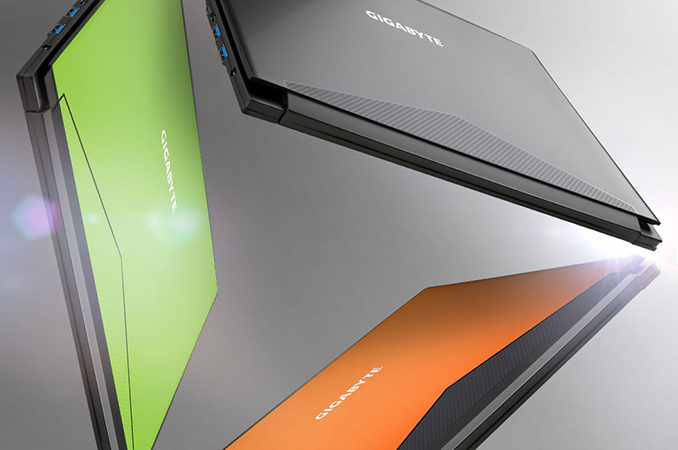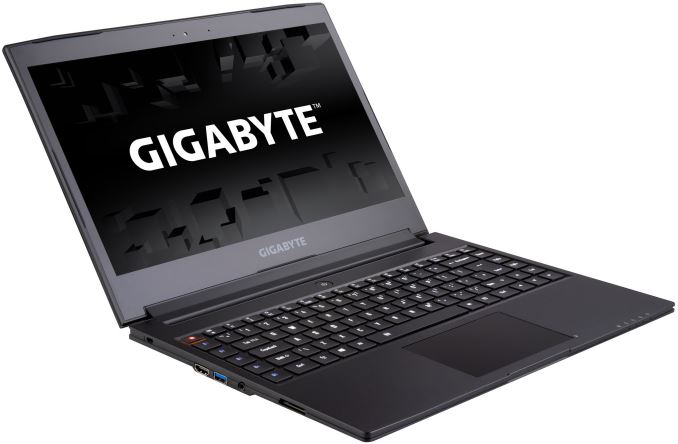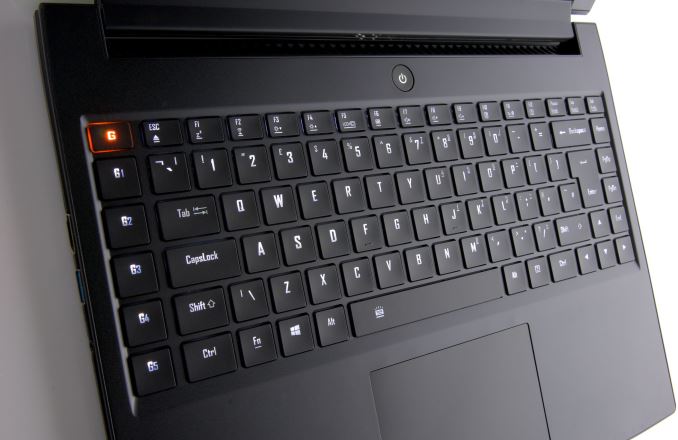GIGABYTE Aero 14: Thin Gaming Laptop with NVIDIA GeForce GTX 970M and 10-Hour Battery Life
by Anton Shilov on May 30, 2016 8:30 AM EST
GIGABYTE has introduced its new Aero 14 gaming laptop, which weds a relatively thin form-factor with high-performance components such as an Intel Skylake-H CPU, and a NVIDIA GeForce GTX 970M GPU, along with a high-resolution display and a claim of a 10-hour battery life. The new notebooks are designed for those who would like to have decent performance in games, but who are not ready to sacrifice mobility for gaming.
The GIGABYTE Aero 14 is based on the Intel Core i7 H-series processor (four cores with Hyper-Threading technology, 6 MB LLC cache, 45 W TDP, dual-channel DDR4 memory controller, integrated Intel Gen9 graphics core) and is equipped with a 14” IPS display panel with a 2560×1440 resolution. The system can be equipped with the NVIDIA GeForce GTX 965M (1024 stream processors, 64 texture units, 32 raster operations pipelines) or the 970M (1280 SPs, 80 TUs, 48 ROPs) graphics adapters, up to 32 GB of DDR4 memory (using two 16 GB SO-DIMMs) as well as two SSDs in M.2 form-factor (with PCIe 3.0 x2 interface). For some reason, GIGABYTE decided not to reveal exact details regarding things like Wi-Fi as well as the amount of VRAM, but it is natural to expect the PC of this class to feature 802.11ac.
In a bid to make the system even friendlier to gamers, GIGABYTE included a keyboard featuring five programmable keys to simplify input of complex key combinations. Other I/O capabilities of GIGABYTE’s Aero 14 include one USB 3.1 Type-C receptacle, three USB 3.0 ports, a TRRS audio connector, a SD card reader, an HD webcam, built-in speakers and microphones as well as an HDMI 2.0 and an mDP display output.
The Aero 14 comes in a full aluminum chassis, though, we are not dealing with a unibody design here. GIGABYTE offers three color options for the display lid, with black, green and orange to emphasize gaming nature of the device.
Despite of rather powerful hardware inside, the Aero 14 boasts with a 10-hour battery life (obviously, when the integrated graphics core is used), which is in-line with that of modern business notebooks. To make such long battery life possible, GIGABYTE integrated a 94.24 WHr lithium-ion polymer accumulator into its gaming laptop. The Aero 14 is 19.9 mm thick and weighs 1.89 kilograms, making it one of the lightest and thinnest notebooks with gaming-grade hardware inside.
The Aero 14 from GIGABYTE will, among other products, compete against Razer’s Blade, which is also relatively thin (17.9 mm) and sports a 14” display. When compared to the Aero, the Razer Blade has a higher resolution 3200×1800 display, slimmer chassis, as well as Thunderbolt 3 support. However, GIGABYTE’s machine has larger battery, potentially more DDR4 memory (because the Blade uses soldered down DRAM and cannot be upgraded), potentially higher amount of storage (thanks to two M.2 slots) as well programmable keys.
Exact pricing of GIGABYTE’s Aero 14 will depend on actual configuration, but typically, gaming machines from the company are not overpriced.
Source: GIGABYTE








_thumb.jpg)
_thumb.jpg)









33 Comments
View All Comments
junky77 - Monday, May 30, 2016 - link
a moment before a GTX 1070M?lexluthermiester - Monday, May 30, 2016 - link
So you're implying the GTX 970M is worthless? That's a silly notion.junky77 - Monday, May 30, 2016 - link
No, I don'tSpunjji - Monday, May 30, 2016 - link
He didn't imply that at all, but the timing does make this a lot less attractive than it would otherwise be.Jttw2 - Monday, May 30, 2016 - link
Lol better for us, the price will probably drop after the 1070m is released :Dkent1146 - Monday, May 30, 2016 - link
We have no idea when a 1070m will come out. It could be 2 months from now, it could be 6 months from now. There's plenty of time to design a laptop, sell it, and do a refresh when a 1070m comes out.junky77 - Monday, May 30, 2016 - link
I agree there is a matter of price - for a good price it could be nice, but initially, you'd get it probably for the same price as these go usually - $1300-$1500. And that's without taking eGPUs into consideration..Solandri - Monday, May 30, 2016 - link
This looks like a replacement for their P34 line, which is close to 3 years old now. New P34G And W models opened at a $1799 price point (currently in the $1300-$1500 range).The full aluminum chassis should help with a lot of the build quality complaints about the P34. In particular, the bottom would warp (on mine the notch next to the memory door has bulged out) so it wouldn't sit flat on 4 feet anymore. The other major quality complaints are a warping trackpad button, and gaps between the screen bezel and lid.
Then there's the heat. The P34's cooling is OK for its size, but the intake ducts are poorly designed. Some owners have cut holes where these ducts are, and reported a 10C drop in temperatures. I can't tell from their pics if they've addressed this (looks like they moved the exhaust vent to the front of the screen, which seems a bit crazy to me with air cooling 80-90C components.
http://www.gigabyte.com/products/product-page.aspx...
junky77 - Monday, May 30, 2016 - link
That's nice to have a $1500 laptop that has a little less build quality problems, but the point is that unlike desktops, the upgrade options and even reliability of a laptop is way more limited (remember also that in many cases, it's all soldered on the motherboard). You are paying $1500, maybe $1200 with some deal, and then what? 2-4 months later, you have half considerably less performance for the price and the purchase lost its value quite quickly.It's not a matter of wanting to have more performance for the price around the clock, just a notion about the consumption industry.
Wouldn't it be nice to have a crowd sourced company working for the people (so to speak)?
forgot2yield28 - Monday, May 30, 2016 - link
Building modularity to facilitate upgradeability tends to increase size. In my opinion, the Dell XPS notebook line gets it mostly right - allow the user to upgrade the memory and storage solutions, as well as offering dual and quad core processors, and Iris and discrete graphics options. Really, after a few generations your motherboard is obsolete as CPUs have moved on to a new socket, and desktops are no different than laptops in this regard. It would be great if MXM graphics modules were more widely supported, but again, this would add bulk and there is something to be said for something you can carry around easily.